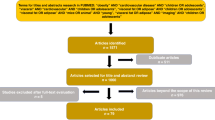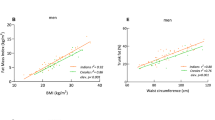Abstract
Background/Objectives:
Little information is available as to the cause of increased thickening of the intima-media of the carotid artery (cIMT) in the pediatric population. Therefore, cIMT was compared in obese adolescents and normal-weight controls, and associations between cIMT and lipid and non-lipid cardiovascular risk factors were assessed.
Subjects/Methods:
Subjects included 61 obese non-diabetic male and female volunteers aged 12–18 years inclusive with a body mass index (BMI) >95th percentile for age and 2-h blood glucose <200 mg dl−1 matched to 25 normal-weight control volunteers with normal glucose levels. Each subject underwent a 2-h glucose tolerance test and measurement of hemoglobin A1c, ultrasensitive C-reactive protein, fasting insulin, blood lipids, visceral, subcutaneous abdominal and hepatic fat, and cIMT.
Results:
Maximum cIMT was 0.647±0.075 mm in the obese subjects versus 0.579±0.027 mm in normal-weight controls (P<0.001). There was no difference in maximum cIMT between male and female subjects. There were significant correlations between maximum cIMT and BMI z-score, 2-h glucose, fasting insulin, homeostasis model assessment (HOMA), total low-density lipoprotein (LDL) cholesterol, very LDL cholesterol, high-density lipoprotein (HDL) cholesterol, HDL2 cholesterol, HDL3 cholesterol, triglycerides, remnant lipoprotein cholesterol, intermediate-density lipoprotein cholesterol, lipoprotein(a), apoprotein B100, abdominal subcutaneous fat volume, visceral fat volume and hepatic phase difference. On multiple regression analysis, visceral fat was the most significant predictor of maximum cIMT. Two-hour blood glucose, HOMA and systolic blood pressure were also significant predictors of maximum cIMT.
Conclusions:
cIMT was increased in the obese adolescents compared with the normal-weight-matched controls. Visceral fat was a key predictor of arterial wall thickening in these subjects. The results suggest that the focus of cardiovascular disease prevention in the adolescent obese should be visceral obesity, and not blood lipids or lipid subclasses.
This is a preview of subscription content, access via your institution
Access options
Subscribe to this journal
Receive 12 print issues and online access
$259.00 per year
only $21.58 per issue
Buy this article
- Purchase on Springer Link
- Instant access to full article PDF
Prices may be subject to local taxes which are calculated during checkout
Similar content being viewed by others
References
Slyper AH . What vascular ultrasound testing has revealed about pediatric atherogenesis, and a potential clinical role for ultrasound in pediatric risk assessment. J Clin Endocrinol Metab 2004; 89: 3089–3095.
Austin MA, Breslow JL, Hennekens CH, Buring JE, Willett WC, Krauss RM . Low-density lipoprotein subclass patterns and risk of myocardial infarction. JAMA 1988; 260: 1917–1921.
Kamigaki AS, Siscovick DS, Schwartz SM, Psaty BM, Edwards KL, Raghunathan TE et al. Low density lipoprotein particle size and risk of early-onset myocardial infarction in women. Am J Epidemiol 2001; 153: 939–945.
Sacks FM, Campos H . Low-density lipoprotein size and cardiovascular disease; a reappraisal. J Clin Endocrinol Metab 2003; 88: 4525–4532.
Wilson HM, Patel JC, Skinner ER . The distribution of high-density lipoprotein subfractions in coronary survivors. Biochem Soc Trans 1990; 18: 1175–1176.
Johansson J, Carlson LA, Landou C, Hamsten A . High density lipoproteins and coronary atherosclerosis. A strong inverse relationship with the largest particles is confined to normotriglyceridemic patients. Arterscler Thromb 1991; 11: 174–182.
Anuurad E, Boffa MB, Koschinsky ML, Berglund L . Lipoprotein(a): a unique risk factor for cardiovascular disease. Clin Lab Med 2006; 26: 751–772.
Rexrode KM, Buring JE, Manson JE . Abdominal and total adiposity and risk of coronary heart disease in men. Int J Obes Relat Metab Disord 2001; 25: 1047–1056.
Yusuf S, Hawken S, Ounpuu S, Bautista L, Franzosi MG, Commerford P et al. Obesity and the risk of myocardial infarction in 27,000 participants from 52 countries: a case-control study. Lancet 2005; 366: 1640–1649.
Canoy D, Boekholdt SM, Wareham N, Luben R, Welch A, Bingham S et al. Body fat distribution and risk of coronary heart disease in men and women in the European Prospective Investigation Into Cancer and Nutrition in Norfolk cohort: a population-based prospective study. Circulation 2007; 116: 2933–2943.
de Koning L, Merchant AT, Pogue J, Anand SS . Waist circumference and waist-to-hip ratio as predictors of cardiovascular events: meta-regression analysis of prospective studies. Eur Heart J 2007; 28: 850–856.
Bhatia LS, Curzen NP, Calder PC, Byrne CD . Non-alcoholic fatty liver disease: a new and important cardiovascular risk factor? Eur Heart J 2012; 33: 1190–1200.
Kulkarni KR . Cholesterol profile measurement by vertical auto profile method. Clin Lab Med 2006; 26: 787–802.
Kulkarni KR, Garber DW, Jones MK, Segrest JP . Identification and cholesterol quantification of low density lipoprotein subclasses in young adults by VAP-II methodology. J Lip Res 1995; 36: 2291–2302.
Kulkarni KR, French KW . Determination of apolipoprotein B100 by the vertical auto profile method (AACC abstract A-128). Clin Chem 2007; 53: A41.
Kulkarni K, Tiwari H, Moore L, Jones S, Apo AI . A novel approach to measure apolipoprotein B/apolipoprotein AI ratio using the vertical auto profile method. Diab Vasc Dis Res [WCIRS abstract] 2007; 4: 266.
Fishbein MH, Gardner KG, Potter CJ, Schmalbrock P, Smith MA . Introduction of fast MR imaging in the assessment of hepatic steatosis. Magn Reson Imaging 1997; 15: 287–293.
Pilleul F, Chave G, Dumortier J, Scoazec JY, Valette PJ . Fatty infiltration of the liver: detection and grading using dual T1 gradient echo sequences on clinical MR system. Gastroenterol Clin Biol 2005; 29: 1143–1147.
Abaci A, Tascilar ME, Saritas T, Yozgat Y, Yesilkaya E, Kilic A et al. Threshold value of subepicardial adipose tissue to detect insulin resistance in obese children. Int J Obesity 2009; 33: 440–446.
Karpoff L, Vinet A, Schuster I, Oudot C, Goret L, Dauzat M et al. Abnormal vascular reactivity at rest and exercise in obese boys. Eur J Clin Invest 2009; 39: 94–102.
Glowińska-Olszewska B, Tolwińska J, Urban M . Relationship between endothelial dysfunction, carotid artery intima media thickness and circulating markers of vascular inflammation in obese hypertensive children and adolescents. J Pediatr Endocrinol Metab 2007; 20: 1125–1136.
Roh EJ, Lim JW, Ko KO, Cheon EJ . A useful predictor of early atherosclerosis in obese children: serum high-sensitivity C-reactive protein. J Korean Med Sci 2007; 22: 192–197.
Atabek ME, Pirgon O, Kivrak AS . Evidence of association between insulin resistance and premature carotid atherosclerosis in childhood obesity. Pediatr Res 2007; 61: 345–349.
Fang J, Zhang JP, Luo CX, Yu M, Lv LQ . Carotid intima-media thickness in childhood and adolescent obesity relations to abdominal obesity, high triglyceride and insulin resistance. Int J Med Sci 2010; 7: 278–283.
Woo KS, Chook P, Yu CW, Sung RY, Qiao M, Leung SS et al. Overweight in children is associated with arterial endothelial dysfunction and intima-media thickening. Int J Obes Relat Metab Disord 2004; 28: 852–857.
Huang K, Zou CC, Yang XZ, Chen XQ, Liang L . Carotid intima-media thickness and serum endothelial marker levels in obese children with metabolic syndrome. Arch Pediatr Adolesc Med 2010; 164: 846–851.
Mangge H, Almer G, Haj-Yahya S, Pilz S, Gasser R, Möller R et al. Preatherosclerosis and adiponectin subfractions in obese adolescents. Obesity 2008; 16: 2578–2584.
Giannini C, de Giorgis T, Scarinci A, Ciampani M, Marcovecchio ML, Chiarelli F et al. Obese related effects of inflammatory markers and insulin resistance on increased carotid intima media thickness in pre-pubertal children. Atherosclerosis 2008; 197: 448–456.
Pacifico L, Cantisani V, Anania C, Bonaiuto E, Martino F, Pascone R et al. Serum uric acid and its association with metabolic syndrome and carotid atherosclerosis in obese children. Eur J Endocrinol 2009; 160: 45–52.
Stabouli S, Kotsis V, Papamichael C, Constantopoulos A, Zakopoulos N . Adolescent obesity is associated with high ambulatory blood pressure and increased carotid intimal-medial thickness. J Pediatr 2005; 147: 651–656.
Meyer AA, Kundt G, Steiner M, Schuff-Werner P, Kienast W . Impaired flow-mediated vasodilation, carotid artery intima-media thickening, and elevated endothelial plasma markers in obese children: the impact of cardiovascular risk factors. Pediatrics 2006; 117: 1560–1567.
Iannuzzi A, Licenziati MR, Acampora C, Salvatore V, Auriemma L, Romano ML et al. Increased carotid intima-media thickness and stiffness in obese children. Diabetes Care 2004; 27: 2506–2508.
Reinehr T, Kiess W, de Sousa G, Stoffel-Wagner B, Wunsch R . Intima media thickness in childhood obesity. Relations to inflammatory markers, glucose metabolism, and blood pressure. Metabolism 2006; 55: 113–118.
Kapiotis S, Holzer G, Schaller G, Haumer M, Widhalm H, Weghuber D et al. A proinflammatory state is detectable in obese children and is accompanied by functional and morphological vascular changes. Arterioscler Thromb Vasc Biol 2006; 26: 2541–2546.
Wunsch R, de Sousa G, Toschke AM, Reinehr T . Intima-media thickness in obese children before and after weight loss. Pediatrics 2006; 118: 2334–2340.
Pacifico L, Cantisani V, Ricci P, Osborn JF, Schiavo E, Anania C et al. Nonalcoholic fatty liver disease and carotid atherosclerosis in children. Pediatr Res 2008; 63: 423–427.
Osiniri I, Sitjar C, Soriano-Rodrígues P, Prats-Puig A, Casas-Satre C, Mayol L et al. Carotid intima-media thickness at 7 years of age: relationship to C-reactive protein rather than adiposity. J Pediatr 2012; 160: 276–280.
Kim SK, Park SW, Kim SH, Cha BS, Lee HC, Cho YW . Visceral fat amount is associated with carotid atherosclerosis even in type 2 diabetic men with a normal waist circumference. Int J Obesity 2009; 33: 131–135.
Cascella T, Plomba S, De Sio I, Manguso F, Giallauria F, De Simone B et al. Visceral fat is associated with cardiovascular risk in women with polycystic ovary syndrome. Hum Reprod 2008; 23: 153–159.
Liu KH, Chan YL, Chan JC, Chan WB . Association of carotid intima-media thickness with mesenteric, preperitoneal and subcutaneous fat thickness. Atherosclerosis 2005; 179: 299–304.
Oh J, Kim SK, Shin DK, Park KS, Park SW, Cho YW . A simple ultrasound correlate of visceral fat. Ultrasound Med Biol 2011; 37: 1444–1451.
Sturm W, Sandhofer A, Engl J, Laimer M, Molnar C, Kaser S et al. Influence of visceral obesity and liver fat on vascular structure and function in obese subjects. Obesity 2009; 17: 1783–1788.
Acknowledgements
We acknowledge the editorial assistance of Jacqueline Grove and the recruiting contributions of Kim Kopfer, both employed by Lehigh Valley Health Network. This study was funded by the Department of Pediatrics at Lehigh Valley Hospital, Allentown, PA, USA.
Author information
Authors and Affiliations
Corresponding author
Ethics declarations
Competing interests
The authors declare no conflict of interest.
Rights and permissions
About this article
Cite this article
Slyper, A., Rosenberg, H., Kabra, A. et al. Early atherogenesis and visceral fat in obese adolescents. Int J Obes 38, 954–958 (2014). https://doi.org/10.1038/ijo.2014.11
Received:
Revised:
Accepted:
Published:
Issue Date:
DOI: https://doi.org/10.1038/ijo.2014.11
Keywords
This article is cited by
-
Multivariate pattern analysis: a method and software to reveal, quantify, and visualize predictive association patterns in multicollinear data
BMC Bioinformatics (2024)
-
An approach to assess and adjust for the influence of multicollinear covariates on metabolomics association patterns—applied to a study of the associations between a comprehensive lipoprotein profile and the homeostatic model assessment of insulin resistance
Metabolomics (2022)
-
Insulin resistance in ischemic stroke
Metabolic Brain Disease (2017)



